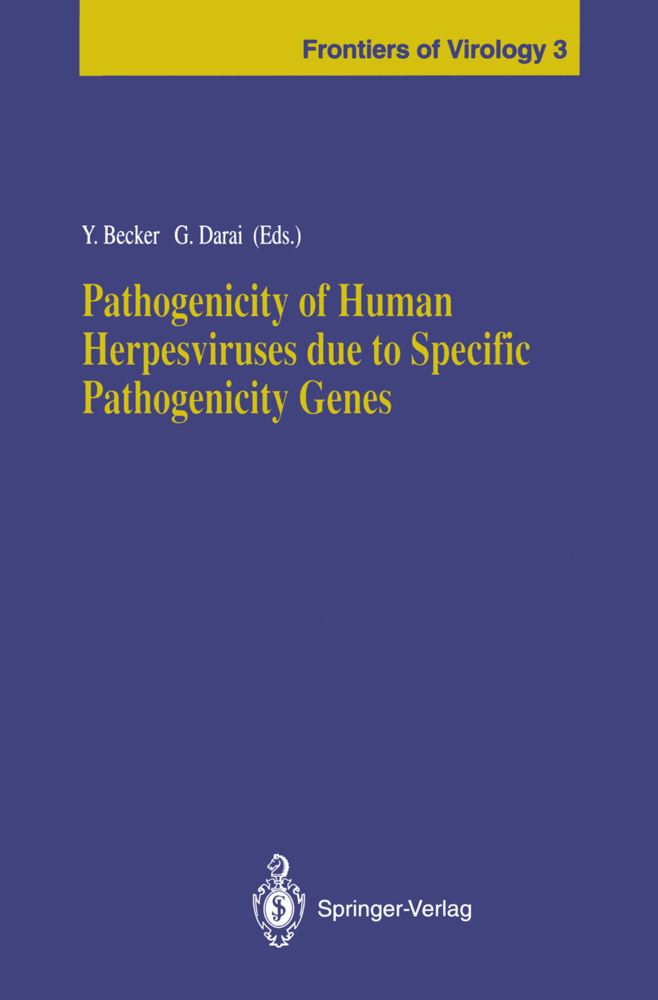Pathogenicity of Human Herpesviruses due to Specific Pathogenicity Genes
Pathogenicity of Human Herpesviruses due to Specific Pathogenicity Genes
Six members of the Herpesviridae family are human pathogens, including herpes and 2 (HSV-I and 2), Epstein-Barr virus (EBV), varicella zoster simplex virus I virus (VZV), human cytomegalovirus (HCMV), and human herpesvirus 6 (HHV 6). Each of these viruses is capable of causing distinct diseases of varying severity in children, young adults, and the aged. The diseases range from infection of epithelial tissue to the infection of internal organs and white blood cells. A common feature of the six pathogenic human herpesviruses is their ability to latently infect different cell types in which the viral DNA is not integrated and is unable to express its pathogenicity. Reactivation of the herpesviruses is a result of cellular processes which reactivate viral genes, leading to virus progeny and to signs of infection. Due to their ability to become latent after initial infection, once the pathogenic herpesviruses infect children they are maintained throughout life, having the potential of cause various diseases upon reactivation.
1 Entry of Herpes Simplex Virus Type 1 into Cells - Early Steps in Virus Pathogenicity
2 Neomycin and Herpes Simplex Virus Receptor Binding: The Role of Glycoprotein C
3 Pathogenicity of Glycoprotein C-Negative Herpes Simplex Virus Type 1 in Herpetic Keratitis
4 Structure and Function of Glycoprotein D of Herpes Simplex Virus
II. Genes Coding for Enzymes
5 The Role of Herpes Simplex Virus Thymidine Kinase Expression in Pathogenesis and Latency
6 Herpes Simplex Virus Type 1 DNA Polymerase: Eukaryotic Model Enzyme and Principal Target of Antiviral Therapy
7 Ribonucleotide Reductase and the Ocular Virulence of Herpes Simplex Virus Type 1
8 Ribonucleotide Reductase Gene in Herpes Simplex Virus Type 2 and Virus Pathogenicity
III. Genes Related to Intraperitoneal Pathogenicity
9 Effect of Herpes Simplex Virus Type 1 UL41 Gene Product on mdr-1 Gene-mRNA in Infected Adrenal Glands
10 Pathogenicity and Latency of Herpes Simplex Virus in the Animal Model System Tree Shrew
11 Computer Analysis of the Protein Coded by Herpes Simplex Virus Type 1 UL56 Gene
IV. Genes and Latency and Intracerebral Pathogenicity
12 The Herpes Simplex Type 1 Virus Latency Gene
13 Neurovirulence of Herpes Simplex Virus Type 1 Accessory Gene Mutants
14 Herpes Simplex Virus Latency and Immediate Early Gene Repression by the Cellular Octamer-Binding Protein Oct-2
15 The Cell Fusion Protein Gene (UL53) of Herpes Simplex Virus Type 1-A Pathogenicity Gene
V. Effect of Cellular Defenses on Virus Pathogenicity
16 Role of Langerhans Cells and Other Dendritic Cells in the Pathogenesis of Herpes Simplex Virus Type 1 Infection
B. Epstein Barr Virus
17 Gene Expression in Burkitt's Lymphoma Cells
18 MolecularMechanisms of the Development of EBV-Related B Lymphomas: Functional Cooperation of EBV with IL-6 and HIV-1
C. Human Cytomegalovirus
19 Murine Cytomegalovirus Genes Influencing Virus Growth and Tropism for Salivary Gland
D. Human Herpesvirus 6
20 Pathogenicity of Human Herpesvirus-6
E. Trends
21 Herpes Simplex Virus Type 1 Genes Involved in Virus Pathogenicity: A Review
22 Live Herpesvirus Vaccines: Serendipity or Engineering of the Virus Genome.
A. Herpes Simplex Virus
I. Genes Involved in Entry1 Entry of Herpes Simplex Virus Type 1 into Cells - Early Steps in Virus Pathogenicity
2 Neomycin and Herpes Simplex Virus Receptor Binding: The Role of Glycoprotein C
3 Pathogenicity of Glycoprotein C-Negative Herpes Simplex Virus Type 1 in Herpetic Keratitis
4 Structure and Function of Glycoprotein D of Herpes Simplex Virus
II. Genes Coding for Enzymes
5 The Role of Herpes Simplex Virus Thymidine Kinase Expression in Pathogenesis and Latency
6 Herpes Simplex Virus Type 1 DNA Polymerase: Eukaryotic Model Enzyme and Principal Target of Antiviral Therapy
7 Ribonucleotide Reductase and the Ocular Virulence of Herpes Simplex Virus Type 1
8 Ribonucleotide Reductase Gene in Herpes Simplex Virus Type 2 and Virus Pathogenicity
III. Genes Related to Intraperitoneal Pathogenicity
9 Effect of Herpes Simplex Virus Type 1 UL41 Gene Product on mdr-1 Gene-mRNA in Infected Adrenal Glands
10 Pathogenicity and Latency of Herpes Simplex Virus in the Animal Model System Tree Shrew
11 Computer Analysis of the Protein Coded by Herpes Simplex Virus Type 1 UL56 Gene
IV. Genes and Latency and Intracerebral Pathogenicity
12 The Herpes Simplex Type 1 Virus Latency Gene
13 Neurovirulence of Herpes Simplex Virus Type 1 Accessory Gene Mutants
14 Herpes Simplex Virus Latency and Immediate Early Gene Repression by the Cellular Octamer-Binding Protein Oct-2
15 The Cell Fusion Protein Gene (UL53) of Herpes Simplex Virus Type 1-A Pathogenicity Gene
V. Effect of Cellular Defenses on Virus Pathogenicity
16 Role of Langerhans Cells and Other Dendritic Cells in the Pathogenesis of Herpes Simplex Virus Type 1 Infection
B. Epstein Barr Virus
17 Gene Expression in Burkitt's Lymphoma Cells
18 MolecularMechanisms of the Development of EBV-Related B Lymphomas: Functional Cooperation of EBV with IL-6 and HIV-1
C. Human Cytomegalovirus
19 Murine Cytomegalovirus Genes Influencing Virus Growth and Tropism for Salivary Gland
D. Human Herpesvirus 6
20 Pathogenicity of Human Herpesvirus-6
E. Trends
21 Herpes Simplex Virus Type 1 Genes Involved in Virus Pathogenicity: A Review
22 Live Herpesvirus Vaccines: Serendipity or Engineering of the Virus Genome.
Becker, Yechiel
Darai, Gholamreza
| ISBN | 978-3-642-85006-6 |
|---|---|
| Artikelnummer | 9783642850066 |
| Medientyp | Buch |
| Auflage | Softcover reprint of the original 1st ed. 1994 |
| Copyrightjahr | 2012 |
| Verlag | Springer, Berlin |
| Umfang | XVI, 387 Seiten |
| Abbildungen | XVI, 387 p. |
| Sprache | Englisch |











